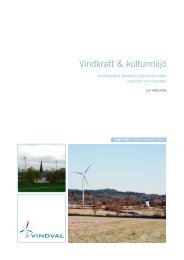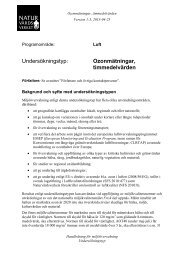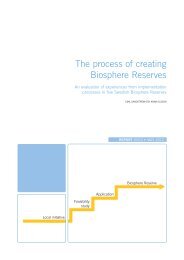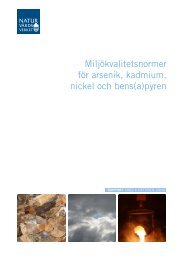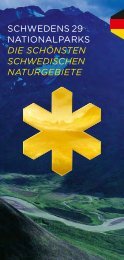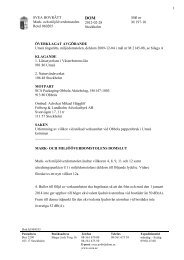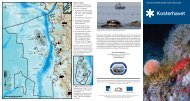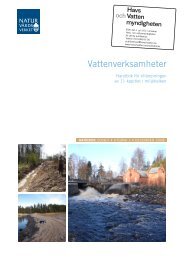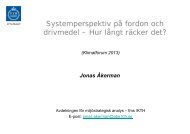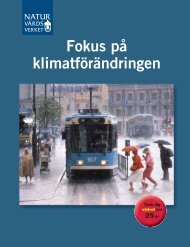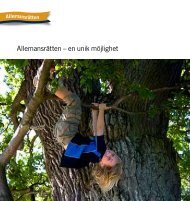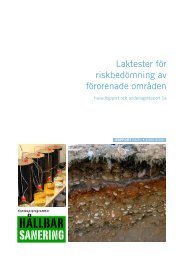Ecosystem services provided by the Baltic Sea ... - Naturvårdsverket
Ecosystem services provided by the Baltic Sea ... - Naturvårdsverket
Ecosystem services provided by the Baltic Sea ... - Naturvårdsverket
Create successful ePaper yourself
Turn your PDF publications into a flip-book with our unique Google optimized e-Paper software.
SWEDISH ENVIRONMENTAL PROTECTION AGENCY<br />
Report 5873 • <strong>Ecosystem</strong> <strong>services</strong> <strong>provided</strong> <strong>by</strong> <strong>the</strong> <strong>Baltic</strong> <strong>Sea</strong> and Skagerrak<br />
Economic Marine Information<br />
Algal beds<br />
Algal beds are important for marine biodiversity and primary production (66). Like<br />
sea-grass beds, <strong>the</strong>y also act as a filter against high nutrient input from terrestrial<br />
sources. Algal beds are undoubtedly beneficial for <strong>the</strong> production of food <strong>by</strong> providing<br />
nursery and feeding habitat for juvenile fish of commercial importance (e.g.<br />
pike, perch and cod). In o<strong>the</strong>r parts of <strong>the</strong> world, and historically in <strong>Baltic</strong> <strong>Sea</strong>,<br />
large algae have been used as fertilizer and in food production. Finally, algal beds<br />
are popular sites for diving and sport fishing (chapter C1). Due to increased nutrient<br />
concentrations and reduced water transparency, erect macroalgae have in some<br />
areas been lost (67) and replaced <strong>by</strong> less productive and supportive habitats including<br />
soft bottoms, mussel beds or communities of red or filamentous algae (68). The<br />
latter often end up covering beaches, with reduced benefits and increased costs for<br />
recreational businesses (69). The effects vary with region; in <strong>the</strong> Bothnian Bay and<br />
in Skagerrak-Kattegat, macroalgae are primarily threatened in proximity to industrial<br />
discharges or sewage treatment plants (70-71). Algal beds may also become<br />
threatened <strong>by</strong> invasive alien species and climate change (72). In <strong>the</strong> <strong>Baltic</strong> <strong>Sea</strong>,<br />
Fucus algae are already stressed <strong>by</strong> <strong>the</strong> low salinity. To counteract loss, <strong>the</strong> restoration<br />
and replacement of algal beds have been initiated in e.g. Himmerfjärden, in <strong>the</strong><br />
Stockholm archipelago (73) as well as in <strong>the</strong> Bay of Gdansk (74). In Himmerfjärden<br />
<strong>the</strong> majority of <strong>the</strong> plants survived transplantation and some even reproduced.<br />
In <strong>the</strong> latter region, <strong>the</strong> project failed and conditions were judged too poor<br />
to allow for continuous trials.<br />
Mussel beds<br />
The blue mussel is one of our most common marine species. It is a very tolerant<br />
habitat builder and considered suitable for cultivation. In Skagerrak and Kattegat<br />
mussel banks are restricted to shallow waters, whereas in <strong>the</strong> <strong>Baltic</strong> proper <strong>the</strong>y<br />
dominate down to as much as 30 m depth. Blue mussels increase biodiversity<br />
(compared to bare substrate) <strong>by</strong> providing substrate for algae and refuge for small<br />
animals (75). There is a direct relationship between <strong>the</strong> size of mussel bank and<br />
species numbers. In addition to providing habitat structure to <strong>the</strong> benthic community,<br />
mussels continuously affect <strong>the</strong> habitat <strong>by</strong> increasing water transparency and<br />
removing toxic substances from <strong>the</strong> water (chapters R3-R5). The tolerance of mussels<br />
extends to most threats. Given a less saline future, <strong>the</strong>y are still likely to persist,<br />
although perhaps smaller in size. How acidification may affect bivalves, however,<br />
remains largely unknown. How <strong>the</strong> development of blue mussels and oysters<br />
is affected <strong>by</strong> predicted changes in pH, is currently under scrutiny (76).<br />
Shallow soft bottoms<br />
Soft bottom seafloors occur along all coasts of <strong>the</strong> <strong>Baltic</strong> <strong>Sea</strong> and Skagerrak, although<br />
<strong>the</strong>ir extent and characteristics differ regionally and locally. These nutrientrich<br />
sediments are highly productive and diverse. Constituting a mosaic of different<br />
structures including sea-grass, sand and shells, <strong>the</strong>y provide habitats and feeding<br />
grounds for numerous species, among which filter-feeders, sea birds and commer-<br />
58



